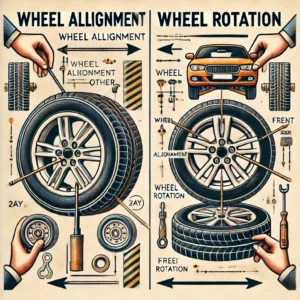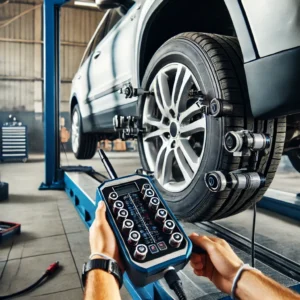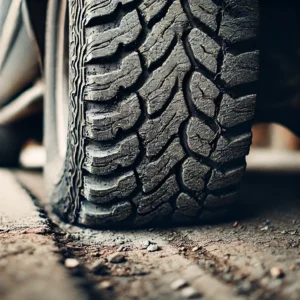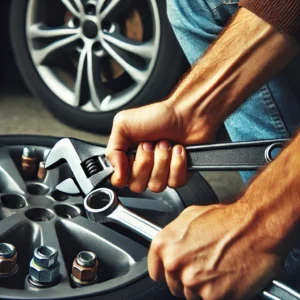Keeping your vehicle’s tires and wheels in good shape is key to a smooth and safe driving experience. Many drivers confuse “wheel alignment” and “tire rotation,” but these services differ. Wheel alignment ensures that your wheels are set to the correct angles, which improves handling and prevents uneven tire wear.

On the other hand, tire rotation involves moving the tires from one position to another, helping even out to wear and extend their lifespan. Both are essential for maintaining your vehicle’s performance and safety, and knowing when you need each can save you time and money in auto repairs. Understanding these differences is crucial for every driver. Wheel alignment and tire rotation are not interchangeable, and neglecting either can lead to expensive auto repairs.

Regularly scheduled maintenance can prevent problems like poor handling, reduced fuel efficiency, and premature tire wear. Staying on top of these services ensures a smoother ride and a longer tire and vehicle life. So, next time you’re at the mechanic, remember to ask about wheel alignment and tire rotation to keep your car running at its best.
What is Wheel Alignment?
Wheel alignment, sometimes called tire alignment or tracking, is the process of adjusting the angles of your vehicle’s wheels to ensure they are perfectly perpendicular to the ground and parallel to each other. Parallel to each other. Proper wheel alignment is essential for optimal handling, steering control, and tire wear.
During a wheel alignment, technicians adjust the following angles:
- Camber: This angle measures the inward or outward tilt of the wheel when viewed from the front or rear of the vehicle. Excessive camber can lead to uneven tire wear and negatively impact your vehicle’s handling.
- Toe: This angle refers to the inward or outward pointing of the wheels when viewed from above. Improper toe settings can lead to excessive tire wear and cause the vehicle to pull to one side.
- Caster: This angle measures the forward or backward tilt of the steering pivot point when viewed from the side. Caster affects steering responsiveness and stability.
Ensuring your wheels are properly aligned is important for several reasons:
- Improved Handling and Control: Properly aligned wheels provide better steering response, stability, and overall vehicle control.
- Enhanced Safety: Misaligned wheels can cause uneven tire wear, reduced traction, and longer braking distances, compromising your safety on the road.
- Increased Fuel Efficiency: Misaligned wheels create additional drag and resistance, reducing fuel efficiency.
- Extended Tire Life: Proper wheel alignment ensures even tire wear, maximizing the lifespan of your tires.
Signs That Your Vehicle Needs a Wheel Alignment
Several indicators may suggest that your vehicle requires a wheel alignment:
- Uneven Tire Wear: It could be a sign of misalignment if you notice excessive wear on your tires’ inside or outside edges.
- Vehicle Pulling to One Side: If your vehicle tends to drift or pull to one side while driving on a straight, level road, it’s likely due to misaligned wheels.
- Crooked Steering Wheel: If your steering wheel is not centered when driving straight, it could indicate a wheel alignment issue.
- Vibrations or Shaking: Misaligned wheels can cause vibrations or shaking in the steering wheel or the entire vehicle, particularly at higher speeds.

What is Tire Rotation?
Tire rotation is the practice of periodically repositioning your vehicle’s tires to promote even wear and extend their lifespan. During a tire rotation, the front and rear tires are swapped in a specific pattern, depending on the type of vehicle and the tire manufacturer’s recommendations.
Tire rotation is an essential maintenance task that helps ensure even tire wear and extends the lifespan of your tires. Here are several common tire rotation patterns:
- Front-to-Rear: The front tires are moved to the rear, and the rear tires are moved to the front, on the same side of the vehicle.
- Cross-Pattern: The front tires are moved diagonally to the opposite rear positions, and the rear tires are moved diagonally to the opposite front positions.
- X-Pattern: In an X-shaped pattern, the front tires are moved to the opposite rear positions, and the rear tires are moved to the opposite front positions.
Tire rotation offers several benefits:
- Maximizes Tire Life: By distributing wear evenly across all four tires, tire rotation helps extend their lifespan.
- Improves Traction and Handling: Evenly worn tires provide better traction, handling, and braking performance, enhancing your safety on the road.
- Saves Money: Regularly rotating your tires can help you avoid premature tire replacement, saving you money in the long run.
Signs That Your Tires Need to Be Rotated
While tire manufacturers typically recommend rotating your tires every 5,000 to 8,000 miles (or as specified in your owner’s manual), there are a few signs that may indicate it’s time for a rotation:
- Uneven Tread Wear: If you notice uneven wear patterns across your tires, it shows that rotation is needed.
- Vibrations or Shaking: Excessive vibrations or shaking, especially at higher speeds, can be caused by uneven tire wear and may require rotation.
- Age of Tires: Even if your tires don’t show significant wear, it’s still recommended to rotate them regularly based on the manufacturer’s guidelines or your driving habits.

Key Differences Between Wheel Alignment and Tire Rotation
Understanding the key differences between wheel alignment and tire rotation is essential for maintaining your vehicle’s health and ensuring a smooth, safe ride. Wheel alignment refers to adjusting the angles of your wheels so they are set to the car manufacturer’s specifications. This process helps your vehicle drive straight, improves handling, and prevents uneven tire wear. When your wheels are properly aligned, your car will not pull to one side, and you will experience a more comfortable driving experience.
On the other hand, tire rotation involves moving your tires from one position to another to ensure even wear. This practice prolongs the life of your tires and improves overall vehicle performance. Typically, the front tires will wear out faster due to steering and braking forces, so rotating them with the rear tires helps balance out the wear and tear. Regular tire rotation, combined with proper wheel alignment, will keep your vehicle running smoothly and extend the lifespan of your tires, saving you money in the long run.
How Often Should You Get a Wheel Alignment or Tire Rotation?
The frequency of wheel alignments and tire rotations varies depending on several factors, including your driving habits, vehicle type, and manufacturer recommendations. Here are some general guidelines:
Wheel Alignment
- Most manufacturers recommend a wheel alignment every 12,000 to 15,000 miles or annually, whichever comes first.
- However, you may need more frequent alignments if you frequently encounter potholes, curbs, or other impacts.
- It is also advisable to get a wheel alignment after any suspension work or significant repairs involving the steering or suspension components.
Tire Rotation
- Most manufacturers recommend rotating tires every 5,000 to 8,000 miles, or as specified in your vehicle’s owner’s manual. Regular tire rotation ensures even wear, extends tire life, improves gas mileage, and provides a smoother ride.
- You may need to rotate your tires more frequently if you drive under severe conditions (e.g., off-road, heavy loads, or high temperatures).
- It’s a good practice to rotate your tires whenever your vehicle is serviced or gets an oil change.
Can You Do Wheel Alignment or Tire Rotation at Home?
While it is possible to rotate your tires at home if you have the necessary tools and knowledge, performing a proper wheel alignment is generally not recommended as a DIY task. Here’s a breakdown of the feasibility of doing these services at home:
Wheel Alignment
- Wheel alignments require specialized equipment and precise measurements to ensure accurate adjustments.
- Attempting a wheel alignment at home can lead to improper adjustments and potentially cause further issues unless you have access to professional alignment equipment and the necessary training.
- Having wheel alignments performed by qualified professionals at a reputable service center is highly recommended.
Tire Rotation
- Rotating tires is a relatively straightforward process that can be done at home if you have the proper tools (e.g., jack, lug wrench, and wheel chocks) and follow the recommended rotation pattern for your vehicle.
- However, exercising caution and following proper safety procedures when working on your vehicle is essential.
- If you’re unsure or uncomfortable with the process, having your tires rotated by a professional service center is best.
-
Whether you perform these services yourself or have them done professionally by an Auto Repair Hurst TX service, following the recommended maintenance schedules is crucial to ensure the longevity and optimal performance of your vehicle’s tires and wheels.
Frequently Asked Questions
Can I skip tire rotations if I have an all-wheel-drive or four-wheel-drive vehicle?
No, tire rotations are still recommended for all-wheel-drive and four-wheel-drive vehicles. While the power distribution may differ, tires still wear at varying rates due to weight distribution, driving conditions, and suspension geometry.
Is a wheel alignment necessary after replacing tires or wheels
It’s generally recommended to have a wheel alignment performed after replacing tires or wheels, especially if you’re changing to a different tire size or type. This ensures the new components are properly aligned and prevents premature wear or handling issues.
Can I rotate my tires in any pattern I prefer
Following the recommended rotation pattern specified by your vehicle’s manufacturer or tire manufacturer is essential. Improper rotation patterns can lead to uneven wear and potentially cause handling or safety issues.
How long does a wheel alignment take
The time required for a wheel alignment can vary depending on the service center and the complexity of the alignment process. However, most standard wheel alignments take approximately 1 to 2 hours to complete.
Can I drive with misaligned wheels or without rotating my tires
While it’s possible to drive with misaligned wheels or without rotating your tires, it’s not recommended. Doing so can lead to excessive and uneven tire wear, reduced handling and control, decreased fuel efficiency, and potential safety risks. It’s best to address these issues promptly to ensure optimal vehicle performance and safety.
Conclusion
At Pit Stop Xpress, we specialize in wheel alignment and tire rotation to keep your car running smoothly and efficiently. Don’t wait until you experience problems with your handling or notice uneven tire wear—schedule your maintenance with us today. Regularly checking and servicing your wheel alignment and tire rotation can prevent costly auto repairs down the road, improve fuel efficiency, and ensure you get the best performance and longevity out of your tires.
Our comprehensive services help maintain your vehicle’s optimal condition, giving you peace of mind whenever you hit the road—Trust Pit Stop Xpress for all your auto repair needs. Our team of experts is dedicated to helping you understand and manage your vehicle’s maintenance so that you can drive confidently.
We use state-of-the-art equipment and techniques to provide top-quality service, ensuring your car receives the best care possible. Whether routine maintenance or more complex repairs, we’re committed to delivering exceptional results. With our professional and friendly approach, you’ll feel assured that your vehicle is in capable hands. Visit Pit Stop Xpress and experience the difference our expertise can make.
End Note
We pride ourselves on delivering the best auto repair and maintenance services to ensure your vehicle remains in top condition. At Pit Stop Xpress, Our expert team is well-equipped to handle everything from tire rotations to comprehensive wheel alignments. Don’t just wait for problems to arise—schedule your maintenance today and keep your car running smoothly.
Explore our wide range of services designed to meet all your automotive needs. From routine maintenance to intricate repairs, we’ve got you covered. Need to get your vehicle inspected? Our state inspections ensure that your car meets all safety and emission standards.
If you wonder about the quality of our work, look at our gallery to see the level of care and expertise we bring to every job. To learn more about our dedicated team and our commitment to excellence, visit our About Us page. We’re here to provide you with the highest standard of service, ensuring your car performs at its best.
If you’re ready to experience the Pit Stop Xpress difference, contact us via our Contact Us page. Whether you need urgent repair or just want to ensure your car is in the best possible shape, our team is here to help.
Choose Pit Stop Xpress for the best auto repair and maintenance services. Visit us and discover why our customers trust us with their vehicles. Drive confidently, knowing your car is maintained by professionals committed to excellence. Join our family of satisfied customers and keep your vehicle in perfect condition with Pit Stop Xpress.


